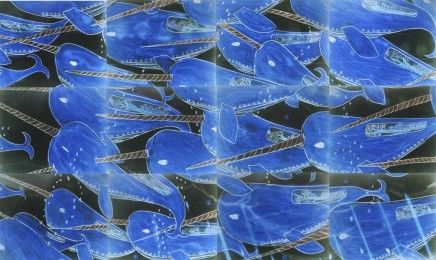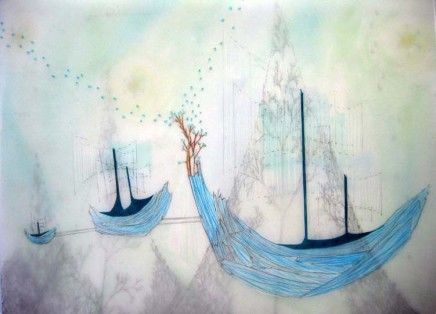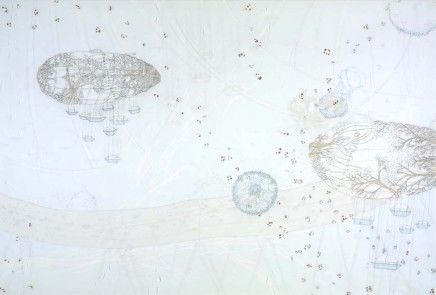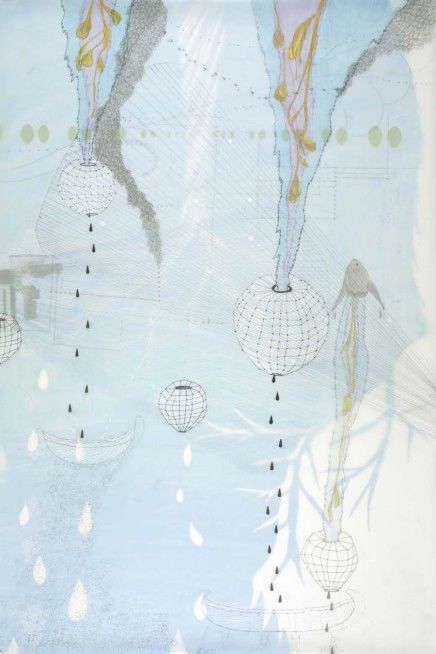
Hammer Projects: Christine Nguyen
- – This is a past exhibition
Christine Nguyen's works on paper are influenced by the artist's memories, landscape imagery, and imagined visions. She combines a variety of media and photographic processes, creating multilayered forms that move freely from representation to abstraction. Natural elements like trees and rivers and whimsical animals share space with fanciful boats and villages, all of which seem to exist in a universe with its own secret logic and energy.

Biography
Christine Nguyen was born in 1977 in Mountain View, California, and currently lives in Glendale. She received a BFA in photography from California State University, Long Beach, in 1999, and an MFA from the University of California, Irvine, in 2004. Her work has been the focus of several recent and planned solo exhibitions, including those at 4-F Gallery and Gallery 825 in Los Angeles; Enview Gallery in Long Beach; and the Angels Gate Cultural Center in San Pedro, California. Her works on paper have also been exhibited in group shows at AndrewShire Gallery, Los Angeles; Mixture Contemporary Art, Houston; the Laguna Art Museum, Laguna Beach, California; and the Society for Contemporary Photography, Kansas City. This is Nguyen's first solo museum exhibition.
Essay
By Kristina Newhouse
In Migration over the Woods and Its Strange Powers (2006), Christine Nguyen envisions a wondrous world populated by chimerical entities that would fit neatly in Jorge Luis Borges's 1954 anthology The Book of Imaginary Beings. Scientific advances—from the nineteenth-century discovery of microscopic unicellular organisms to twenty-first century theories of deep space—have informed Nguyen's cosmogonic sensibilities. As a mythmaker, she derives an understanding from science of the systems by which her entities come into being, sustain themselves in their environment, procreate, and ultimately perish. The life forms in her fantastical world engage in complex and interrelated behaviors. Each creature has been given a specific modality and set of tasks, from shelter and transportation to the dissemination of collective wisdom.
Visitors to Nguyen's alternative reality are presented with an array of odd and fanciful beings. Diatomaceous elements resembling non-Cartesian urban topographies drift past gnarled, hydralike limbs that have broken free from a grand arboreal mandala. Craggy jellyfish islands sustain both plant life and human settlements from a series of rootlike tentacles. A flock of long-billed birds wings energetically across the vast habitat; discernible along their underbellies is a row of square panels that suggest the windows of an airplane. As the bird/carriers pass through the titular woods, they are mysteriously transformed into narwhals. Charged with a new task, each narwhal has a large vacuole in its torso that encapsulates trees and a cityscape, forms of vestigial knowledge from the past that the nomadic pod of marine mammals must transport into the future.
Within Nguyen's idealistic construct, there are no borders that separate one organism from another. Evolution is an inherently synthetic, almost ingestive process. When an entity ceases to function, nothing is lost. Rather, its structure and contents are wholly absorbed into the expanding ecosystem. Animals merge with vegetation, the inanimate is incorporated into the living, and the organic melds with the technological. Under these conditions, the status of her biotechnological hybrids is always "in-between." In the recent narratives of postcolonialism, such in-betweenness provides for the possibility of difference without the assumed or imposed restraints of fixed identity.
Certainly a strain of heterogeneous utopianism wends through Nguyen's artwork, reflecting the appeal of an increasingly symbiotic relationship between humanity and the technology we have spawned. Nguyen traces her fascination with utopian ideals to Buckminster Fuller's hopeful neoteric ambitions for humankind. She also finds inspiration in the Pop-era architectural group Archigram, which proposed such wildly novel projects as Ron Herron's mechanical Walking City (1964) to break away from the dehumanizing strictures of postwar architecture. Additionally, she cites author Ernest Callenbach's cult classics Ecotopia (1975) and Ecotopia Emerging (1981), which provided impetus for the development of the transnational Green Party.
Guided by a childlike imagination, Nguyen begins her foray into artificial ecology by drawing scenes into multiple layers of transparent Mylar. Mindful of a desire to create play between translucency and opacity, she utilizes a variety of media and techniques, from hard, clean lines of pencil or pen and dense, blurry bursts of spray paint to softer washes of ink, thinned acrylic, and watercolor.
With little regard for the inviolability of the finished work, Nguyen rends her drawing into wide strips. She feeds these long remnants through a photo enlarger as if the layered scraps were color negative film. Broken into sequential cells of imagery, the drawing is projected onto sixteen-by-twenty-inch sheets of photosensitive paper. The photos are then run through a color processor to fix them in their negative state. Finally Nguyen arranges the counterimages into a large-scale gridded facsimile of the original drawing.
In the completed piece, light and dark are transposed. Complementary colors are inverted. The usual hierarchy in which positive space takes precedence over negative is overturned. Because Nguyen deliberately shifts the darkest hues of the photographs from absolute black to a more greenish register, the white expanse of background in her spare and delicately rendered source drawing becomes a vitreous yet strikingly robust green-gray that predominates in the new composition. All other pictorial elements pick up a greenish cast as a consequence of the color shift. Those elements that were drawn onto the sublayers manifest as ghostly silhouettes rising to the inky surface as if suspended in deep liquid.
Through her photographic sleight, Nguyen's imagery becomes once removed from the actual. The mark as an index of handiwork is supplanted by the hermetic structure of pure image. Under such circumstances, the inverted world that she depicts seems all the more phantasmagoric. This impression is reinforced by minute imprecisions in the photographic act, which result in compositional elements that periodically break, skip, or repeat across adjoining cells. These imperfections conform to the characteristic slippages of time, sequence, and space within dream logic.
Interestingly, Nguyen's photomural mimics the entoptic phenomenon known as the afterimage. An aberration resulting from the eye's own function, the afterimage is a physiological artifact of sight that is observed—frequently in reverse—upon a screen of closed eyelids. A figment transiently situated somewhere between external stimulus and perception, the afterimage is often employed by therapists and spiritual guides as a cynosure to direct a subject’s thoughts inward during the first stage of hypnosis, after which a liminal trance state is induced.
Liminality describes an ephemeral and transitional mode in which the customary norms that govern behavior are suspended. Barriers are lifted between the realms of the ordinary and magic, the conscious and unconscious, the living and dead. Liminal states allow humanity to catch sight of potentialities that have not yet been externalized and fixed into structure. In his seminal text The Ritual Process: Structure and Anti-Structure (1966), anthropologist Victor Turner describes how the "in-betweenness" of liminality provides the fertile conditions in which new symbols, myths, rituals, and philosophical systems are conceived.
Viewers of Migration over the Woods and Its Strange Powers are extended an invitation to leave behind the everyday and engage the liminal metaphysical substrate of make-believe. This place is filled with familiar mythic themes such as death and regeneration, the epic journey, hybridization and transformation, and the much-anticipated reunification of disjoined parts into a harmonious totality. By entering this alternative landscape, viewers are encouraged to reflect upon basic social values and, further, to contemplate humanity's relationship to nature in an age of rapid biotechnological advances. Through her xenophilic imaginings, Christine Nguyen taps into our eternal longing for a better future to offer a representation of life as it could be.
Kristina Newhouse is curator of the Torrance Art Museum.
Hammer Projects are made possible with support from The Horace W. Goldsmith Foundation, the Annenberg Foundation, Fox Entertainment Group's Arts Development Fee, the Los Angeles County Arts Commission, members of the Hammer Circle, and the David Teiger Curatorial Travel Fund.














